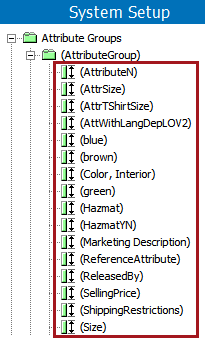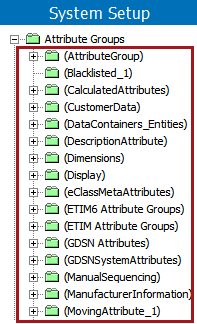When setting dimension dependency on attributes and attribute groups, there are some considerations. This topic explains several recommendations and warnings when working with dimension dependent attributes and attribute groups.
Dimension Dependent Attribute Recommendations
- Be consistent about the context in which you create the attributes.
The names of the attribute will not be visible in other contexts until they are translated and will instead display the attribute ID in parentheses, as pictured below.

- Carefully consider dimension points when defining attributes.
Even if you are only publishing in one language or country today, it is much easier to remove a dimension dependency from an attribute than it is to add one later.
Dimension points should be applied to attributes such as description attributes, feature attributes, and benefit attributes, which truly contain data that could become dimension-dependent in the future. This may seem like an extra task in the beginning, but if business conditions change, it is much easier to remove dimension dependencies from attributes than it is to add a dimension dependency to attributes that already have values.
Note: Remember that if an attribute does not have a dimension dependency assigned, all data values are stored in the 'All' level.
For the step-by-step process for moving data from an top level to a language level, refer to the Adding Dimension Dependency After Loading Data topic.
Dimension Dependent Attribute Warnings
- Do not create attributes with multiple dimension dependencies.
Only language is supported in translation tracking—no other tools exist in STEP to identify changes in other dimensions. For more information on the translation functionality of STEP, refer to the Translations topic.
- Do not make attribute links to categories dimension dependent.
Dimension-dependent attribute links can be handy but be aware that they are also hard to maintain. If for instance, if you want to create / modify these attribute links via STEPXML imports and some links should be visible in more than one context, you are forced to create a 'cross-context' import file with qualifiers, as you cannot make the links visible in one context at a time.
Attributes That Need Dimension Dependencies
|
Questions to ask |
Recommendation |
|---|---|
|
Would the data be presented differently if it were published in another language (for example, long descriptions or feature bullets)? |
If so, make the attribute language dependent, even if you only have one language today. |
|
Would the data appear exactly the same if it were published in another language (for example, Y/N, T/F, and numeric values)? |
If so, do not add a dependency |
|
Would the data be presented differently if the product were sold in another country (for example, warranty)? |
If so, make the attribute country dependent. If not, do not add a dependency. |
|
If the attribute is owned by another system, does that system have the ability to store multiple language or country-dependent values? |
If not, do not add dependencies. |
Dimension Dependent Attribute Group Recommendations
Attribute groups should have a dimension dependency if you would like to display the attribute group names in their own language.
Note: Making attribute groups dimension dependent is a global setting and does not affect attributes within the group.
- If you add a language dependency to attribute groups, be consistent about which context you are in when you create the groups. The names of the groups will not be visible in other contexts until they are translated.

- Determine a standard process for translating attribute groups and attributes. Always start in the same language and have a consistent process.
Dimension Dependent Attribute Group Warnings
- Do not make attribute groups dependent on anything other than language.
- If there is no requirement to add a dimension dependency, do not add one.